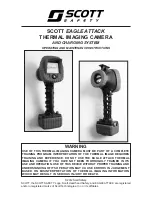
FlashSight™ User’s Guide
Copyright © 2006, FLIR Systems, Inc. 431-0002-09-10 Version 100
5
3 Quick-Start
Information
The following instructions will get you started with basic operation of the
FlashSight.
1. Insert 4 AA batteries inside the battery case as shown in Figure 2,
being careful to align the positive and negative battery terminals as
depicted in the embossed diagram on the case.
2. Insert the battery case into the FlashSight battery compartment as
shown in Figure 3. The compartment is keyed to prevent the case from
being inserted upside-down.
Note
The FlashSight battery compartment is designed to accept the included battery case
only. Do not insert batteries directly into the compartment without using the case.
3. Press the on/off button on the left side of the FlashSight assembly as
shown in Figure 4. You should hear one or more audible “clicks” from
the sight. This is the internal shutter, which is used to automatically
improve the uniformity of the detector array at periodic intervals. Open
the lens cap by rotating it upward, as shown in Figure 5.
4. Hold the eyecup to your eye, pressing slightly against your face to
open the eyecup flaps. Adjust the eyepiece focus by rotating the
eyepiece, as shown in Figure 6. If necessary, also adjust the focus of
the lens assembly as shown in Figure 7.
Note
The eyepiece focus adjustment optimizes the focus of the eyepiece for your vision
and should only be required once. The lens focus adjustment optimizes the focus of
the infrared imager, and can be varied during operation depending upon whether you
are imaging distant or nearby targets. Begin by adjusting the eyepiece focus while
looking at the crosshair on the display. Then adjust the lens focus while looking at
the image of the object you are trying to see. If the crosshair is not displayed when
you first power the unit, see Section 4.4 for directions on how to display it.
5. To turn the unit off, press and hold the on/off button for two seconds.
The display will go black, indicating that the system is powered down.
You have now completed the basic steps for using the imager. However, it is
recommended that you read the rest of this User’s Manual to learn how to
adjust the image according to your preferences, how to override automatic
shutter operation, how to capture and download images, and how to maintain
your FlashSight system.








































